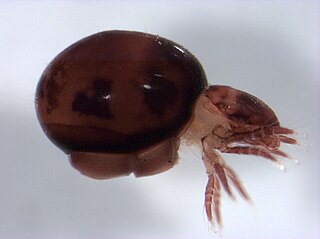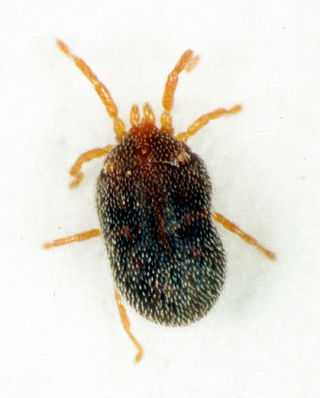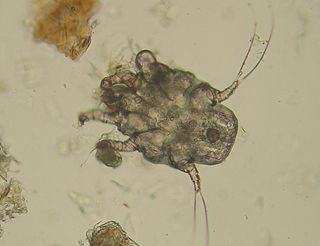
Mites are small arachnids. Mites span two large orders of arachnids, the Acariformes and the Parasitiformes, which were historically grouped together in the subclass Acari, but genetic analysis does not show clear evidence of a close relationship.

Trombicula, known as chiggers, red bugs, scrub-itch mites, or berry bugs, are small arachnids in the Trombiculidae family. In their larval stage, they attach to various animals, including humans, and feed on skin, often causing itching and trombiculosis. These relatives of ticks are nearly microscopic, measuring 0.4 mm (0.01 in) and have a chrome-orange hue. A common species of harvest mite in North America is Trombicula alfreddugesi.

Oribatida, also known as oribatid mites, moss mites or beetle mites, are an order of mites, in the "chewing Acariformes" clade Sarcoptiformes. They range in size from 0.2 to 1.4 millimetres. There are currently 12,000 species that have been identified, but researchers estimate that there may be anywhere from 60,000 to 120,000 total species. Oribatid mites are by far the most prevalent of all arthropods in forest soils, and are essential for breaking down organic detritus and distributing fungi.

Balaustium is a genus of mites belonging to the family Erythraeidae. These are large red mites with one or two pairs of eyes set well back on the body.

Astigmatina is a clade of mites in the superorder Acariformes. Astigmata has been ranked as an order or suborder in the past, but was lowered to the unranked clade Astigmatina of the clade Desmonomatides in the order Sarcoptiformes. Astigmatina is now made up of the two groups Acaridia and Psoroptidia, which have been suborders of the order Astigmata in the past. Astigmatina contains about 10 superfamilies and 76 families under Acaridia and Psoroptidia.

The Prostigmata is a suborder of mites belonging to the order Trombidiformes, which contains the "sucking" members of the "true mites" (Acariformes).
The Raphignathoidea is a superfamily of the Acari (mite) order Trombidiformes, comprising 1087 species in 62 genera and 12 families.

Histiostomatidae is a family of mites in the clade Astigmata.

Trombidiidae, also known as red velvet mites, true velvet mites, or rain bugs, are small arachnids found in plant litter and are known for their bright red color.

The Trombidiformes are a large, diverse order of mites.

The Laelapidae are a family of mites in the order Mesostigmata. The family is also referred to in the literature as Laelaptidae, which may be the correct spelling.
The family Ameroseiidae is one of the three families of mites under the superfamily Ascoidea. There are about 12 genera and more than 130 described species in Ameroseiidae. The family has a worldwide distribution.
Abrolophus marinensis is a species of mite belonging to the family Erythraeidae. It is named after the Marine de Farimore, Corsica, where the species was first collected. A. marinensis differs from its cogenerate species in its palptarsus having 2 setae with a tufty tip. It particularly differs from Abrolophus longicollis in its shorter length measurements.
Allothrombium polikarpi is a species of mite belonging to the family Trombidiidae, first described from Greece.

Hydryphantidae is a family of mites in the order Trombidiformes. There are more than 30 genera and 130 described species in Hydryphantidae.
Thyasidae is a family of mites in the order Trombidiformes. There are about 7 genera and more than 30 described species in Thyasidae.

Hydrachna is a genus of mites in the family Hydrachnidae, the sole genus of the family. There are more than 80 described species in Hydrachna.

Rhodacaroidea is a superfamily of mites in the order Mesostigmata. There are 6 families with more than 900 described species in Rhodacaroidea, found worldwide.
Guntheria coorongensis is a species of mite in the family Trombiculidae, found from the tip of Cape York in Queensland to South Australia.
Neosomy is the formation of new external structure in an active stage of an invertebrate, in a taxon that normally only changes during moulting. It occurs in nematodes and a wide range of arthropods, especially those with symbiotic lifestyles.













